
Arquivo para a ‘Social Network’ Categoria
A power hidden in little ones
Throughout history, the layers of society that had no participation in power have been ignored, not in authoritarian regimes where this is evident, even though dictators enjoy some popularity due to their power of manipulation and use of force, the majority of society must and the The process becomes irreversible with access through social media, which can be networks.
have been ignored, not in authoritarian regimes where this is evident, even though dictators enjoy some popularity due to their power of manipulation and use of force, the majority of society must and the The process becomes irreversible with access through social media, which can be networks.
The power of weak ties, unknown to most manipulators and authoritarians, exists and even if subjected to a harsh regime, in the shadows and in informal media it ends up manifesting itself, however, the power of propaganda and mass media in the mainstream media was immense.
It is true that part of the so-called popular opinion is also subject to traditions and cultures of oppression and manipulation, it was so before, and now it can become perverse, but when used to promote the common good, equality and respect, it can be the only asymmetric force.
Oppression always presupposes a certain consent, by persuasion, by fear or by some circumstantial or historical convenience, but over time, it may take years, a true “public” opinion will prevail and the polarization of the imperial forces at play will weaken. .
How to recognize the wolf and the lamb in this game is simple, and the biblical parable explains it (John 10:12):
“The mercenary, who is not a shepherd
and does not own the sheep,
sees the wolf coming, abandons the sheep and runs away,
and the wolf attacks and scatters them.”
The shepherd knows the sheep and they listen to his voice, says another biblical passage, and he does not act with power, but as a protector and facilitator of the sheep’s path so they don’t get lost.
The strength of weak ties
The theory of networks, not in the focus of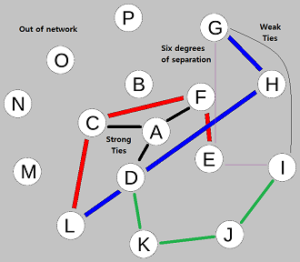 social media, but of the ties between actors has some curious properties and two are very special: the six degrees of separation and the strength of weak ties (Weak ties) that seem strange to those who are unaware the theory.
social media, but of the ties between actors has some curious properties and two are very special: the six degrees of separation and the strength of weak ties (Weak ties) that seem strange to those who are unaware the theory.
The six degrees of separation indicate that seen as networks, the relationships between social actors are, in reality, more connected than one imagines, and this is not just in the world of social media (which is incorrectly put equivalent with social networks).
A classic experiment, called the Milgram experiment due to the work of psychologist Stanley Milgram, who sent letters to certain distant people, and identified ties of personal knowledge existing between any two people, and discovered an average distance of 5.5 people to letters reach their destination.
The experiment had flaws, such as letters that were not sent forward and ended up in an intermediary and the lack of knowledge of the objective of certain people in the experiment, for example, not understanding that the letter should go as close to the final destination.
The weak ties experiment carried out by Mark Granovetter (1973) takes into account the weakest and most distant contacts in social networks, and can, in certain contexts, mean that the ties between two people who have similar interests are strong, even if they pass by some intermediary C, and this makes C also part of the strong loop.
So the weak tie will be just the opposite, A and B have distant interests and connection routes, which can mean different or just distant interests, however in network theory these ties are important for the functioning of the network and its dynamization, unlike the what common sense says.
What Granovetter researched is that the greater the strength of the bond between two people, the greater the chance that the circle of friends and ties will be common and that the message will only stay in that circle, not reaching other circles of relationships and expanding the network.
In this sense, limiting or banning social networks means reducing and making the social network (which is not necessarily done via the media) limited, however, there are networks that commit certain crimes and should not be legitimized and, when possible, banned.
This is discussed within the issue of power, because the theory of networks contradicts the idea of an increasingly stronger and centralized power as a solution to social problems, because even if prohibited, social networks continue to function as established by the theory of the six degrees of power. Separation and distance between actors is smaller than centralized power assumes, as it is often isolated in its social or ideological “bubble”.
Social networks dynamize the structures of social ties and ignoring them can be a source of empowerment for different social groups and helps to grow true popular will.
GRANOVETTER, Mark S. The Strenght of Weak Ties. The American Journal of Sociology, vol. 78, n. 6, p. 1360-1380, may 1973.
Arbitrary power and socialization
In his book “In the swarm: a digital perspective” Byung Chul-Han  clarifies that only a relationship is symmetrical (both sides have the same power or the same power) respect, if respect is lacking there is always an arbitrary exercise of power , but let’s look at other definitions.
clarifies that only a relationship is symmetrical (both sides have the same power or the same power) respect, if respect is lacking there is always an arbitrary exercise of power , but let’s look at other definitions.
A widely used one is that of Norberto Bobbio: “… every probability of imposing one’s will in a social relationship, even against resistance, whatever the basis of this probability (Weber, 1994, p.33), there is always the possibility of “manipulation”, use of reward, threat of punishment and other forms of asymmetry that favors force.
Generalizing the different forms of power, and contrary to Foucault (see the previous post), Lebrun says that power and domination go hand in hand, a person has power when the other is deprived of it, he puts them in the same boat: m Marx, Nietzsche, Weber , Raymond Aron, Wright Mills and others.
This conception comes from North American sociology known as “Zero Sum Theory”, a theory that dates back to Hobbes, which defined the power of the “sovereign” or the State, as being “one against all” and “in favor of all at the same time”. time”, but from top to bottom.
Thus, this power is simply applied as an obligation or prohibition to the dominated, passing through them and through them, in the same way, the dominated also use it and rely on it, but the dominated have subjectivity (in the ontological relationship it is dasein), and they produce new knowledge about power relations and also empower themselves. In this sense, it is important to relate power to potency, or capacity for action.
The concept of act and power in Thomas Aquinas is, however, more complete, because it is also related to truth, not temporal, but ontological, present in Being:
“[…]some things may be, although they are not, while others actually are. What can be (illud quod potest esse) is called potential being; what already is (illud quod iam est) is called being in act. However, being is double: the essential or substantial being of the thing, like being a man, is simply being; the other is being accidental, like the man being white; and that is being other.” (AQUINO, T, 1976, p. 39.)
Thus power is seen in another way, which is also matter and being complete, for Aquinas all are basic components of the substance, the notion of being complete is attributed both to the form that signifies the first act, the actuality, that the form possesses by itself and not by a mediator, when this first act is attributed to matter there will be an actuality, that which today is confused with virtuality (the potency or possibility of being), because in this way every being is in potency, in this way everyone can have power in order to realize its full potential.
This means that it is necessary to empower man, society and recover the disempowered, so re-education, resocialization and even those who are socialized are always possible.
Power, if exercised without arbitrariness and with the dimension of everyone, can and should serve the common good, justice and freedom.
AQUINO, T. (1976) De principiis naturae ad fratrem Sylvestrum, [ed. H.F. Dondaine]. Ed. Leon., t.XLIII, Opuscula, vol.IV. Roma [Santa Sabina]: Editori di san Tommaso.
LEBRUN, G.(1999) O que é poder. Brazil, São Paulo: Brasiliense.
WEBER, M. (1994) Economia e Sociedade. Brazil, Brasília – DF: Editora da Universidade de Brasília, 1994.
A piece in the chess of war
Since the fall of the monarchy in Iran, at the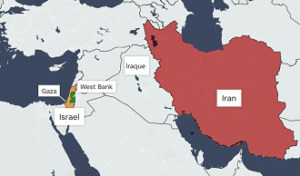 time Shah Reza Pahlavi, who was a traditional ally of the USA, the Islamic republic of Iran began to have hostility with the USA, which imposed sanctions because of the processing of uranium essential for nuclear bombs, making causing Iran to seek support and form alliances with Russia.
time Shah Reza Pahlavi, who was a traditional ally of the USA, the Islamic republic of Iran began to have hostility with the USA, which imposed sanctions because of the processing of uranium essential for nuclear bombs, making causing Iran to seek support and form alliances with Russia.
In 1st. April this year, Israel launched an attack on Syria (not assumed), killing Iranian generals, who have since promised retaliation and recently attacked Israel’s territory with drones and missiles, according to Rear Admiral Daniel Hagari, Israeli military spokesman: “it will launched more than 300 threats, and 99% were intercepted”, and concluded: “this is a success”.
Shortly before the news of the launch this Saturday (13/04), Israeli Prime Minister Benjamin Netanyahu said that “the defensive systems” are working, and that the IDF (Israel Defense Force), in a reprisal that was already As expected, the bombers continued yesterday (04/14).
As there are strong connections with Hezbollah and the Houthis to the south in Yemen and Hezbollah to the north in Lebanon there is also news of attacks on Israel, both the Israeli military command, the G7 and the UN security council have already called a meeting yesterday.
Italy and Germany have already spoken out against Iran, condemning the attacks, the USA and France helped intercept the missiles (it is reported that Jordan also helped the defense), so Iran is isolated in the West.
The objective at the moment is to prevent a larger scale attack on Iran, which would trigger an escalation of war in the region, Netanyahu must attack some targeted targets in Iran.
Russia has not commented so far, but it is a traditional ally of Iran, and the drones used in the attack on Israel are the same type as those used in the war in Ukraine.
Russian attacks continue to escalate in Ukraine with the main objective of depleting the country’s energy sources, the progressive fragility of the defense of Ukraine’s military forces makes the situation in the country, and to a certain extent in the NATO countries, quite dramatic.
Peace is always possible, what ethical forces call responsibility could play a decisive role in decision-making, as the leaders involved in the conflict increasingly seem not to understand the gravity of a conflict in the midst of a civilizational crisis.
After World War II, the forces in conflict understood the need for peace, now the worsening of the crisis, paradoxical as it may be, can make leaders call for peace.
Eminent danger of war and hope for peace
A drone attack on the Zaporizhzhia plant last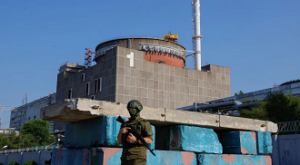 week triggered an alert from Russia that promptly denounced the danger and consequences of a nuclear disaster would be dire.
week triggered an alert from Russia that promptly denounced the danger and consequences of a nuclear disaster would be dire.
It was not clear exactly what weapon was used against the nuclear plant (photo), only that they were drones and that one had been detonated on site. The International Atomic Energy Agency (IAEA), which has experts on site, said only that the information was “consistent” with the entity’s observations, that is, a drone had exploded near the Plant.
International analysts still see the conflict as unlikely due to the catastrophic risk due to the possibility of using nuclear weapons, in addition to conventional combat, the use of cyber and hybrid attacks would be put into motion, initially in Eastern Europe, but with the risk of expanding to Europe and other continents.
Even though NATO holds a significant advantage in both geopolitics, Finland and Sweden joined NATO and Hungary, which sought a position of neutrality, is now strengthened with a military technology agreement made with Sweden, which facilitated its entry into NATO.
Russia, however, has military capabilities combined with economic resources and the modernization of its military apparatus, in addition to a support agreement with China and North Korea, so maintaining peace and preventing conflicts must be done through constant dialogue, but Russian diplomacy continues to play hard and says that dialogue with NATO is “zero”.
Both Russian Foreign Minister Sergey Lavrov and Kremlin spokesman Dimitry Peskov make statements that imply that the conflict with NATO is already underway, diplomatic strategy or pure rhetoric, the fact that tension levels are rising .
NATO responds with military exercises and troop movements on the borders, in January an exercise involved 90 thousand soldiers, new training was announced by NATO commanding general, Christopher Cavoli, the operation called Defensor Firme 24 (Steadfast Defender 24) had already been carried out in other years, but now it takes place amid an intensification of bombings against Kiev.
The hope is that the balance is fragile and both sides know this, and the risk of war would be catastrophic, even though analysts avoid saying that there would be limits on actions.
Polycrisis and hope
Rumors of confrontation between Russia and NATO have worsened in the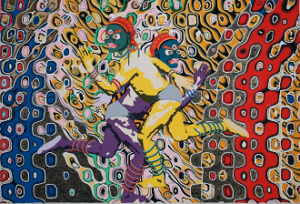 last few hours, however, the hope for peace and the resistance of the Spirit, as portrayed by Edgar Morin, remain alive.
last few hours, however, the hope for peace and the resistance of the Spirit, as portrayed by Edgar Morin, remain alive.
In addition to Morin’s polycrisis (just as poly is multiple and is also city polis, Krisis also has the meaning of decision-making power) professor Adam Tooze (Financial Times article), of history at Yale University (USA) expanded and updated: pandemics, droughts, floods, mega storms, forest fires, war in Ukraine (and now in the Gaza strip0, energy and food prices, etc.
In his reasoning, without directly pointing out the professor “discovers” the complexity and a new transdisciplinary vision of the “whole”: “A problem becomes a crisis when it challenges our ability to deal with it and, thus, threatens our identity. In a multiplicity of crises, the shocks are differentiated, but they interact in such a way that the whole is more ambiguous than the sum of its parts”, he states in the article. (in the image the painting by Tsherin Sherpa (Nepal), Lost Spirits, 2014.)
Morin said: “Linked to the domain of calculation in an increasingly technocratic world, the progress of knowledge is incapable of conceiving the complexity of reality and in particular human realities. The result is a return to dogmatism and fanaticism, and a crisis of morality while hatred and idolatries spread” (Newspaper La Repubblica, interview), however, beyond the polycrisis there are signs of hope.
While the Resistance of the Spirit invokes an understanding of the gravity and issues surrounding the current crisis, Hope (capitalized here) means this Spirit put into action and thus the achievement of a countercurrent spirituality that invokes values of change.
Those who immerse themselves in this Hope in different ways, are always willing to embrace the problems that everyone runs away from, to embrace the fragments of a polarized world, and to remember what unites as opposed to what disunites and polarizes, fortunately there are these spirits and I would call them Spirits of Resistance through Hope.
Go to the World and Bring the Good News, it cannot just be a biblical key, it is Living Hope.
Pre-war and hope for peace
Russia declared a state of war with Ukraine, what changes are the methods and an increase in the limits of violence, the tactic is to bomb the entire country and especially the installations that supply energy, of course except the Atomic Power Plants, but it is not free from an “accident” that would be a severe blow across Europe.
what changes are the methods and an increase in the limits of violence, the tactic is to bomb the entire country and especially the installations that supply energy, of course except the Atomic Power Plants, but it is not free from an “accident” that would be a severe blow across Europe.
Ukraine in response has made incursions into Russia mainly to target oil plants and deposits, which is why the attack on Crimea has been strategic, and also why Russia has warned that it will not attack NATO forces, except F-fighters. 16.
In addition to Macron, who declared that he does not rule out, if necessary, sending troops to Ukraine, Polish Prime Minister Donald Tusk also warned that Europe is in a “pre-war” although he added that there is a “long way to go before facing the “threat” posed by Russia.
Polish Prime Minister Donald Tusk warned that Europe is in a “pre-war era” but still has a “long way to go” before it is ready to face the threat posed by Russia.
The recognition by most European governments that a war with Russia would not be simple is a brake on warmongering threats and opens a path to peace. There are already barely visible articulations in the mainstream press of attempts at agreements, which are seen as “secret ”, but it is not the truth, political and economic interests also act in this area.
The situation of humanitarian calamity and war remains between Israel and neighboring anti-Semitic forces, there is a danger that this feeling will become normalized where only the Palestinian side is emphasized, of course the people are never to blame for the war of the powerful, the Russian and Ukrainian people are also victims , but extreme warlike actions must be charged and punished.
The resistance of the spirit, a word coined by Edgar Morin, must be present in our minds and attitudes, ideological and cultural polarization throughout the world (the terrorist act in Russia has cultural connotations, it seems), must not feed our spirit.
We always hope for serenity, the recognition that everyone loses in a war, especially the innocent and civilians, but it feeds a powerful war industry that serves a perverse economy and hardens spirits.
For Christians, Easter is the victory over death, over hatred, it is a victory of peace.
Declared war and dangers
After Russia openly declared that it is at war with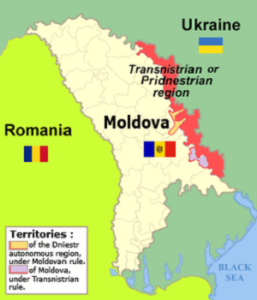 Ukraine in a week of heavy missile attacks on Kiev, including using Polish airspace, which generated tension, Ukraine responded with another major attack on Crimea and oil refineries.
Ukraine in a week of heavy missile attacks on Kiev, including using Polish airspace, which generated tension, Ukraine responded with another major attack on Crimea and oil refineries.
The West was on alert because the price of oil is expected to rise, and tension with NATO and Europe is already at high levels, statements by Putin and Macron with provocations from both sides, the placement of Russian troops on the Finnish border, and an Islamic State attack on a concert hall in Moscow.
From the beginning, the climate of tension has been at its highest this week of Holy Week, there will be no shortage of false prophets and hate mongers to make the situation worse, as Eduardo Galeano said about war, what the hatred of war did not do to the complete media, There have always been cold analysts who think of war as politics since Sun Tzu on the art of war, until Carl von Clausewitz was resurrected to justify the unjustifiable “art” of War.
The small autonomous territory of Transnistria (image) was shaken by the downing of a military helicopter, is within Moldova and governed by pro-Russian forces and is a cause of fear for Moldova, which is a member of NATO.
On the other dangerous front, among the many wars across the planet is the crisis in Palestine, it is another war of strong polarization, where the solution to the crisis seems distant, with increasing hatred from both sides and which could spread throughout the Middle East. .
In addition to the oil problem, the dangerous increase in maritime circulation of grains and industrialized products could generate a supply crisis and affect the problem of hunger, which is already common in many areas of the planet.
This is not an apocalyptic or prophetic vision, if it exists it is for a few and the majority are charlatans and speculators, but the civilizational crisis already has a very visible horizon.
Edgar Morin and other calm and common-sense analysts call for “resistance of the spirit”, not allowing oneself to be contaminated by this climate of hatred, violence and terror that plagues almost all four corners of the planet.
Keep your soul and heart pure and a strong spirit that faces the storms.
The ontological truth
There is a difference between the logic that is based on purely human reason, and the ontological one based on the reality of Being and its existence, thus it is not a final truth, but an eschatological one, that is, it has a beginning and an end where existence is explained. .
In a purely philosophical way, ontic and ontological truth always refer differently, to the being in its being and to the being of the being, and the relationship between them is called ontological difference, little explored in philosophy and embedded in any theory that deals with of Being.
The relationship of latency between being and being and between presence and being makes it evident that the foundation of ontological difference is presence, according to Heidegger (pg. 102):
Unveiling of being is, however, always true of the being of the being, whether it is actually real or not. And vice versa, in the unveiling of beings there always lies an unveiling of their being. Ontic truth and ontological truth always refer, in different ways, to the being in its being and to the being of the being. They are essentially part of each other due to their relationship with the difference between being and being (ontological difference).
It is about unveiling because to reveal is to remove a layer of the veil, but finding another that equally covers the truth, human reason and science itself goes like this, based on Karl Popper’s falsifiability principle, he claims that the fact of a That an assertion can be shown to be false is one of the principles for establishing sound science.
There is a circular relationship between ontic truth and ontological truth resulting from this circular facticity of presence [which is one of Heidegger’s translations of Dasein] and this relates to beings understanding being, and relates to being understanding beings.
“With the differentiation, which is in itself clear, between ontic and ontological – ontic truth and ontological truth, we effectively have the different elements of a difference, but not the difference itself” (pg. .412), explicitly saying the relationship of things with beings, is different from the relationship between beings among themselves, there is an ontological truth that must be revealed for the relationship.
So, how do ontological and ontic truth, as well as ontological difference, contribute to showing the relational character of the self? Conflicts and relationships involve this Being that is relational, but its understanding seen as instrumental, reified or of interest is nothing.
Heidegger, M. (1984) Sobre a essência do fundamento. In: Heidegger: conferências e escritos filosóficos. Transl. de Ernildo Stein. Brazil. São Paulo: Abril Cultural (collection: Os Pensadores).
Total war threats
Macron and Putin’s statements scare Europe,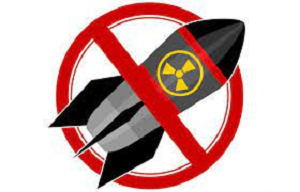 although neutrality is not the exact term for involvement due to NATO’s presence in several countries, now Sweden and Finland, bordering Russia.
although neutrality is not the exact term for involvement due to NATO’s presence in several countries, now Sweden and Finland, bordering Russia.
In an interview with the newspaper Le Parisien, published last Saturday (16/03), Macron declared: “Prepare for all possible scenarios” and added “perhaps at some point this will have to be done”, and “everyone will assume their responsibilities “, provoking reactions of different types, some against and others in favor.
In response, Putin said that if any Western country sends troops to Ukraine, a war between Russia and NATO would be inevitable, and threatened to use nuclear weapons “capable of destroying civilization”.
Putin has a highly secret electronic command and control briefcase called “Kazbek”, it is believed that Russian Defense Minister Sergei Shoigu and the Russian Chief of Staff Valery Gerasimov also have these briefcases, they would control more than 4300 nuclear warheads.
Also NATO plans to implement a rotational air defense model in Lithuania are taking shape, according to Lithuanian Defense Minister Arvydas Anušauskas.
Russia’s election with 87% of votes for Putin was criticized in the West, Germany called it “pseudo-elections”, the French newspapers “simulacrum”, finally opponents arrested or killed and a lot of repression against the opposition.
Putin stated that Russia would consider testing a nuclear weapon if the United States did so, in 2023 the Russian president withdrew Russia from the Comprehensive Nuclear Test-Ban Treaty (CTBT), although it is reported that Russia did not carry out any tests , recently tested the Bulava missile (SS-NX-30 in NATO classification) can be equipped with ten nuclear warheads.
The tone has risen, but also the resistance of spirit and hope has not diminished, peace is possible.

